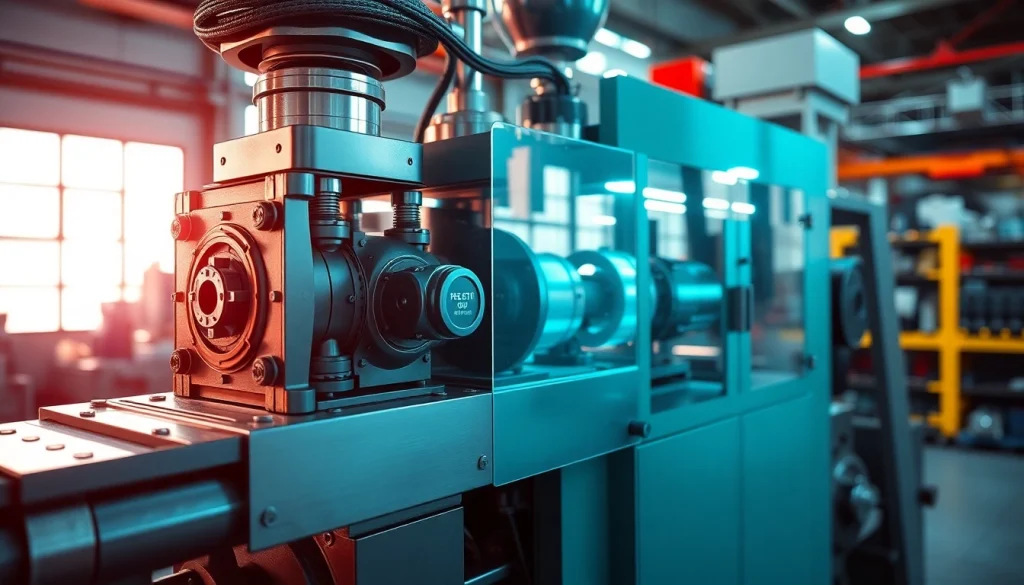Introduction to Blow Molding Machines
Blow molding machines play a pivotal role in the manufacturing sector, primarily focused on creating hollow plastic products. They are efficiently utilized in various industries where hollow forms are essential, such as in packaging, automotive, and consumer goods. This technology offers impressive speed, precision, and versatility in producing an extensive range of products. The Blow Molding Machine exemplifies the advancement in this field, highlighting capabilities that cater to the rising needs of manufacturing.
What is Blow Molding?
Blow molding is a manufacturing process used to produce hollow plastic parts. It starts with melting plastic and shaping it into a parison, a preliminary form that is then inflated within a mold. As air pressure inflates the parison, it takes the shape of the mold, forming products such as plastic bottles, containers, and other hollow objects. The process includes various methods that optimize production efficiency and product quality, adapting to the needs of different applications.
Applications of Blow Molding Machines
The applications of blow molding machines are vast and varied, reflecting the range of products that can be produced through this technique. Some of the prominent uses include:
- Packaging: Blow molding is commonly used to manufacture plastic bottles for beverages, personal care products, and household cleaners.
- Automotive Components: Many automotive parts, including fuel tanks and air ducts, are produced using blow molding.
- Consumer Goods: Products such as toys and gardening products benefit from the lightweight and durable characteristics of blow-molded components.
- Industrial Containers: Larger containers and drums for chemical and liquid storage are effectively produced through this method.
Why Choose Blow Molding?
Blow molding offers numerous advantages that make it a favored choice in manufacturing:
- Efficiency: The blow molding process is fast, allowing for a high throughput of products in a short time.
- Versatility: Various materials, including different types of plastics, can be used, providing manufacturers with the flexibility to choose based on product requirements.
- Cost-Effectiveness: High-volume production leads to cost reductions, especially in labor and material usage, making it an economically viable option.
- Sustainability: Many blow molding processes can incorporate recycled materials, contributing to environmentally friendly manufacturing practices.
Types of Blow Molding Processes
Understanding the different types of blow molding processes is crucial for selecting the most suitable method for your manufacturing needs. Each type has its methodology and ideal applications, providing varied results based on the specific demands of production.
Extrusion Blow Molding (EBM)
Extrusion blow molding is one of the most common techniques used in the blow molding industry. In EBM, melted plastic is extruded into a parison, which is then inflated into a mold. This method is particularly suitable for producing large, hollow objects such as containers and automotive parts.
Key benefits of EBM include:
- Ability to produce large and complex shapes effectively.
- Higher production rates due to continuous processes.
- Flexibility in material use, allowing for various types of plastics.
Injection Blow Molding (IBM)
Injection blow molding combines both injection molding and blow molding processes. In this method, a preform is created with injection molding before being transferred to a blow mold where it is inflated. IBM is particularly advantageous for creating smaller, precise, and high-quality hollow products.
Benefits include:
- High dimensional accuracy and repeatability.
- Production of thinner walls and improved aesthetic quality.
- Less post-processing required for parts, reducing labor costs.
Stretch Blow Molding (SBM)
Stretch blow molding is a variant that involves stretching the parison both axially and radially, which aligns the molecular structure of the plastic, resulting in stronger and clearer products. This method is predominantly utilized for producing PET bottles.
Advantages of SBM include:
- Enhanced strength and durability of the final product.
- Improved clarity and aesthetics, crucial for consumer products.
- Ability to produce lightweight containers without sacrificing strength.
Key Features of Modern Blow Molding Machines
Modern blow molding machines are equipped with advanced technology, enhancing their capabilities and efficiency. Understanding the key features can guide manufacturers in making informed decisions when investing in machinery.
Energy Efficiency
Energy consumption is an essential aspect of manufacturing reliability and cost management. Modern blow molding machines, such as those with servo-driven systems, optimize energy use ensuring that machines operate within energy-efficient parameters, reducing costs and minimizing environmental impact.
Automation and Precision
Automation has become a defining characteristic of contemporary blow molding machines. Enhanced automation technology allows for greater precision, reducing waste, and increasing production consistency. Automated adjustments to molding parameters lead to improved quality and reduced cycle times.
Material Versatility
Today’s blow molding machines can process a wider range of materials than ever before, including recyclable materials and specialty plastics. This versatility provides manufacturers with the flexibility needed to adapt to changing market demands and environmental regulations.
Cost Considerations in Blow Molding
When investing in blow molding machinery, understanding the cost implications is crucial for achieving a favorable return on investment. Various aspects need to be considered, including initial setup costs, maintenance expenses, and the prospective returns from production efficiency.
Initial Investment vs. Long-term Savings
The initial cost of acquiring a blow molding machine can vary significantly based on the technology used and the production capacity. While high-quality machines may require substantial upfront investment, the long-term savings, such as reduced labor costs and efficient energy use, can result in lower operational costs over time.
Maintenance Costs
Proper maintenance is essential for maximizing the lifespan and efficiency of blow molding machines. Investing in quality machines can reduce downtime and minimize repair costs. Regular servicing and adherence to recommended operating protocols are key to ensuring longevity and operational efficiency.
ROI for Business Owners
Business owners must analyze the return on investment for blow molding systems. Metrics such as production rates, reduction in scrap rates, and cost savings from energy efficiency can be calculated to assess the viability of investing in specific machinery. Utilizing cost analysis models helps in making informed financial choices that align with business goals.
Future Trends in Blow Molding Technology
The blow molding industry is constantly evolving, driven by technological advancements and the quest for sustainable manufacturing practices. Keeping abreast of trends can position businesses advantageously in the competitive market.
Sustainability in Blow Molding
As the world shifts towards more environmentally responsible practices, the blow molding industry is integrating sustainability into its operations. The use of biodegradable materials, closed-loop recycling systems, and energy-efficient machines reflects a growing commitment to sustainable production.
Innovations on the Horizon
Emerging technologies such as advancements in automation, enhanced machine learning analytics, and AI-driven optimization are anticipated to shape the future of blow molding. Innovations may yield even faster production cycles, lower material waste, and improved product quality.
Industry Adoption and Trends
The adoption of Industry 4.0 principles will likely accelerate in blow molding manufacturing, heralding a new era of interconnected machines and data-driven decision-making. As industry players embrace digital transformation, they will benefit from improved efficiencies, predictive maintenance, and enhanced product lifecycle management.





